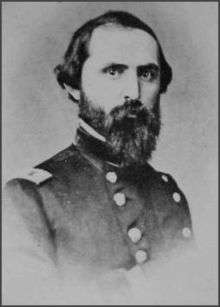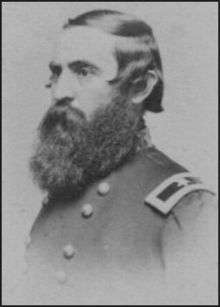William Wallace Burns
| William Wallace Burns | |
|---|---|
 William Wallace Burns | |
| Born |
September 3, 1825 Coshocton, Ohio |
| Died |
April 19, 1892 (aged 66) Beaufort, South Carolina |
| Place of burial | Arlington National Cemetery |
| Allegiance |
United States of America Union |
| Service/branch |
United States Army Union Army |
| Years of service | 1847–1889 |
| Rank |
|
| Commands held | Philadelphia Brigade |
| Battles/wars |
Mexican-American War American Civil War |
William Wallace Burns (September 3, 1825 – April 19, 1892) was a career American soldier who served in the Union Army during the American Civil War, reaching the rank of brigadier general in the volunteer army. He was among the commanders of the famed Philadelphia Brigade.
Birth and early years
Burns was born in Coshocton, Ohio, son of future U.S. congressman Joseph Burns and a distant relative of George Washington through his mother's family. He entered the United States Military Academy in 1842 and graduated 28th in his class in 1847, a year late due to failing English as a freshman. He accepted a commission as a second lieutenant in the infantry and served in the Mexican-American War without seeing any combat. He was then assigned to various army posts in the Old West and Southwest, marrying in Arkansas in 1849. He served on recruiting duty in Philadelphia from 1854–1856 and then as a regimental Quartermaster in Florida during the Third Seminole War (1856–1857). After the conclusion of that conflict, Burns was part of an expedition sent to Utah in 1857 to quell Mormon unrest. In 1858, he accepted a staff commission to serve as Chief Commissary of Subsistence for Albert Sidney Johnston, with the rank of captain.[1]:6–12
Civil War

Burns was stationed at Fort Smith, Arkansas when the war began, narrowly avoiding capture when that place fell to Confederate militia forces on April 23, 1861. He returned to Ohio after the fort's capture and was quickly appointed as Chief of Commissary on the staff of Major General George B. McClellan in May 1861. Burns served in that capacity during McClellan's successful campaign in western Virginia that summer, and was promoted to the Regular Army rank of Major in August 1861. However, Burns wanted a combat command; he got his wish that fall, receiving a promotion to Brigadier General of Volunteers in September, and being placed in command of the Philadelphia Brigade in October, after the death of their previous commander at the battle of Ball's Bluff.[1]:21–24
Burns commanded the Philadelphia Briagde for just over a year (October 1861-November 1862), most notably during McClellan's Peninsular Campaign in the spring and summer of 1862. He led the brigade in a pivotal role at the battle of Savage Station (June 29), a rear-guard action fought to protect the Army of the Potomac as it retreated away from Richmond. Despite receiving a painful facial wound, Burns and his brigade successfully drove off a Confederate attack and allowed the Union withdrawal to continue without interference. His brigade played another important role in the battle of Glendale on the following day, fending off a Confederate attack that had already routed one Union division, and helping to prevent the strung-out Union army from being cut in half. Perhaps his greatest contribution to history occurred earlier in the campaign; during the battle of Fair Oaks (May 31), Burns had ordered his men to assist an artillery battery that had gotten stuck on a rickety plank bridge over a flooded river. Burns' men helped move the cannon off the bridge and through the mud on the other side, allowing the battery to be in place in time to play a significant role in driving off the last Confederate attack of the day. Even more importantly, a shot fired by that battery severely wounded Confederate General Joseph E. Johnston, who was replaced after the battle by Robert E. Lee.[1]:27–55
Burns' facial wound grew infected, causing him to miss several months of fighting as he recuperated. He served as a division commander during the battle of Fredericksburg in December 1862, afterwards he moved on to the Western theater, believing that he was going to be promoted to Major General and receive a corps command in the Army of the Cumberland under William S. Rosecrans. Unfortunately, Burns' promotion was never approved by Congress, and he could not take command of a corps without it. Burns believed that his promotion had been deliberately blocked by Secretary of War Edwin M. Stanton, as punishment for being a strong supporter of General McClellan, a man Stanton despised (no evidence has yet been found that Stanton ever did this). Despite pleas from friends to not act rashly, Burns decided to take his case directly to President Abraham Lincoln; he submitted his resignation as a general in the Volunteer army to Lincoln, hoping that the president would turn it down and force Stanton to allow his promotion. Instead, Lincoln accepted Burns' resignation without comment, forcing him to return to his career in the Commissary department. He never commanded troops in combat again, and he never got his promotion to Major General.[1]:54–78
Later he became chief commissary officer of the Department of the Northwest and during the last part of the war was chief commissary of the Department of the South. He briefly served as the military mayor of Charleston, South Carolina in 1868.
He received the brevet of brigadier general in 1865 and was on duty in the Commissary Department at Washington until 1889, when he retired, with the Regular Army rank of colonel.
He is buried at Arlington National Cemetery.
See also
References
- 1 2 3 4 Ward, David Earl, 1977- (May 2005). The wrong kind of general: the resignation of union brigadier general William W. Burns. Master's thesis, Texas A&M University. Available electronically from http://handle.tamu.edu/1969.1/2351.
![]() This article incorporates text from a publication now in the public domain: Gilman, D. C.; Thurston, H. T.; Colby, F. M., eds. (1905). "article name needed". New International Encyclopedia (1st ed.). New York: Dodd, Mead.
This article incorporates text from a publication now in the public domain: Gilman, D. C.; Thurston, H. T.; Colby, F. M., eds. (1905). "article name needed". New International Encyclopedia (1st ed.). New York: Dodd, Mead.
External links
| Preceded by Peter Charles Gaillard |
Mayor of Charleston, South Carolina 1868 |
Succeeded by Milton Cogswell |
